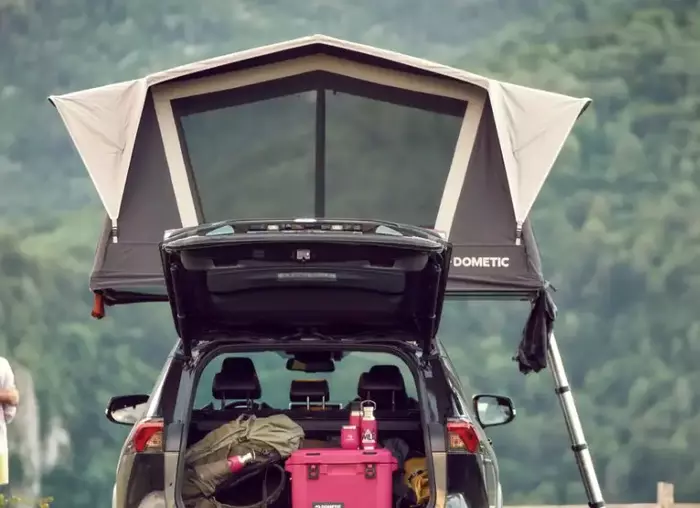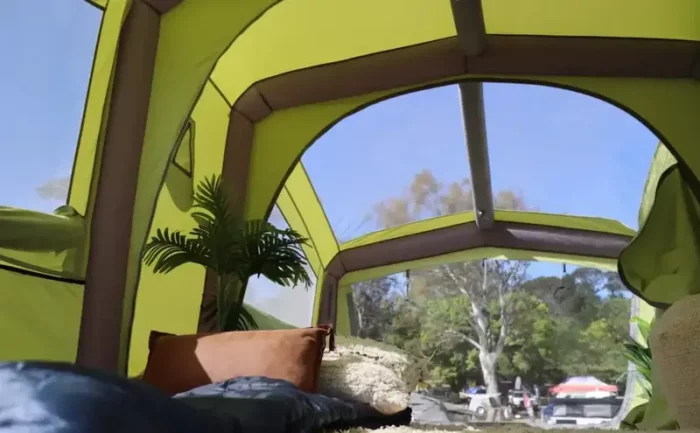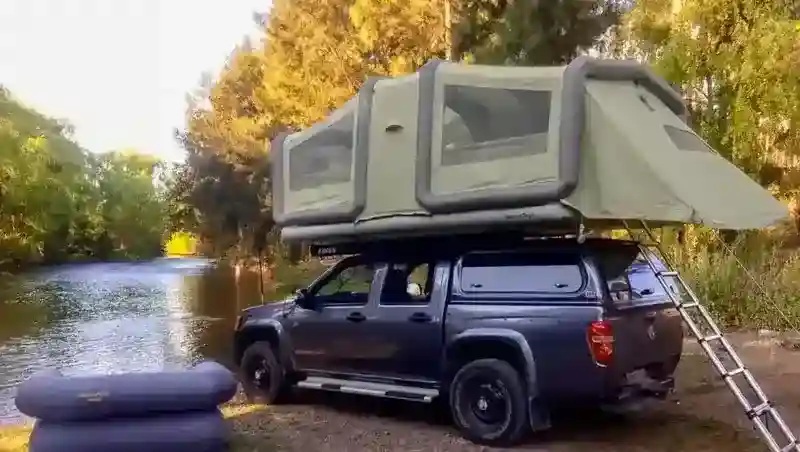Perhaps you did not know but inflatable roof top tents have been around for at least 8 years or so. Just like ground inflatable tents, these roof top versions are becoming increasingly more popular. Read here why.
Inflatable roof top tents are a specific sub-type of soft shell roof top tents. They are supported by inflatable beams instead of any solid support elements. Here are some of the most important features of these inflatable roof top tents that make them popular.
- Inflatable roof top tents are among the lightest of all roof top tents.
- These tents can also be very compact.
- They are expandable similar to other soft shell roof top tents.
- Some of them are the largest roof top tents on the market.
- Single point inflation.
- Great inner height.
The best known brands of inflatable roof top tents
If you follow the roof top tents industry, you will notice that inflatable roof top tents are rare on the US market, but there are many of them in the EU.
In fact, as of the moment of writing this text, they are all in the EU, or they have some branches on other continents. The names include:
- GentleTent.
- Dometic.
- Fjordesen.
- Decathlon Quechua.
These are all European brands, and the first of them in the list also has a branch in Australia. The top picture above shows one of their tents from GentleTent Australia branch. So if you are in the US, and you have not heard of them, this is not surprising.
From what I can find on the site of GentleTent, they claim that they built the first inflatable roof top tent in 2014. As for Dometic, this is a brand known for some of the largest ground family camping tents. They have many inflatable camping tents on the market. The same holds for Decathlon and its Quechua brand.
The weight of inflatable roof top tents
It is best to see some examples, so here are a few:
- Quechua Rooftop tent VAN500 is a 2-person shelter and it weighs 23.6 kg including 7.2 kg ladder.
- GentleTent GT Sky Loft (the top picture above) is currently the largest roof top tent in general. This is a 6-peson tent and it weighs only 49 kg, plus a telescopic ladder of 6 kg. The inner space here is (L x W x H) 340 x 200 x 140 cm. So you have no less than 6.8 square meters of area inside, large enough for family camping.
So some of these roof top tents are incredibly light and they can be used on any car. This is important to stress as there are limits regulated by low and exceeding them mat result in penalties.
Inflatable roof top tents are compact and thin when packed
It is best to continue with numbers, so take the same examples again.
- The Quechua Rooftop Tent VAN500 measures 140 x 37 x 32 cm.
- The GentleTent GT Sky Loft pack size is (L x W x H): 166 x 146 x 16 cm. Observe how thin it is when packed.
This is why with some of these tents the speed limit is 130 km/h and this is higher than in some other types and designs.
Expandable design
This feature is not something unique to inflatable roof top tents only. You have this also in soft shell roof top tents and also in some of clamshell roof top tents.
The mentioned GentleTent GT Sky Loft inflatable roof top tent is so huge because it folds (and unfolds) from both sides. See the top picture above.
Ease of use – single point inflation
In some cleverly constructed models of these inflatable roof top tents, you have a single valve design. So you attach the pump and inflate it from one point.
Usually, you have a pump included. The picture below shows one great example of that type, this is the Dometic TRT 140 AIR roof top tent.

Of course, this does not make them easier to use than some of the hard shell roof top tents, but this is still a great feature and you should know about it. Below you can see how those inflatable beams look from inside, this is the mentioned GentleTent GT Sky Loft tent.

Can inflatable roof top tents withstand extreme weather conditions?
You probably know that roof top tents in general are not the best option for windy conditions. Well, this is even more so with inflatable roof top tents, but they still have some advantages.
Namely, air beams will never break under wind pressure. This is well known from ground air beam tents. They can bend but they instantly restore their shape when the wind pressure drops.
But ground inflatable tents have guylines to stabilize them against the wind. This is not so with roof top inflatable tents. So although the wind cannot destroy such a tent, it can bend it and deform temporarily. So if you are inside in such situations, you cannot feel great, and it is best to avoid windy places.
Is an inflatable roof top tent worth the investment?
Roof top tents are generally expensive, in fact, they are by far the most expensive outdoors shelters that are in the group belonging to tents. The same applies to these inflatable variants.
So if you are on a budget, better forget. You can buy a much larger ground inflatable tent that will cost you 10 times less, and I am not joking.
But these roof top tents look great, and you are well off the ground, safe from larger animals, snakes, and insects. You would not sleep on the ground in an area with crocodiles, wouldn’t you?
Let me know what you think, there is a comment box below. For more texts of this type please check under the category Roof Top Tents here in the site. In particular, check my comparison of clamshell and pop-up roof top tents.
Bookmark this site and visit it occasionally, it is all about off-ground tents and you will always have new texts added here. Thank you for reading and have a nice day.

 Hi, I am Jovo, the founder of this Off-Ground Tents site and several other outdoor sites. I have been mountaineering for almost 40 years already, and I have created this site to use as a reference for various types of above ground tents.
Hi, I am Jovo, the founder of this Off-Ground Tents site and several other outdoor sites. I have been mountaineering for almost 40 years already, and I have created this site to use as a reference for various types of above ground tents.